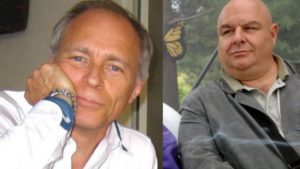Behind the Bivolaru Case. 2. GéPS, the Strange Origins of a French Anti-Cult Group
by Massimo Introvigne
Article 2 of 4. Read article 1.
Few had heard of a new anti-cult association that claimed credit for the arrest of the MISA founder in France. The story of its founder Hughes Gascan is not without interest.

After Romanian yoga teacher Gregorian Bivolaru was arrested in France on November 28, 2023, media started reporting that a small private anti-cult organization founded in 2022, called GéPS (Groupe d’étude du phénomène sectaire, Study Group of the Cult Phenomenon) had a crucial role in the investigation that led to the police raid. While the anti-cult ideology in general and French anti-cult movements in particular have been studied by scholars such as Susan Palmer and even exposed as dangerous for religious freedom by the U.S. Commission on International Religious Freedom, GéPS was almost unknown before November 2023.
To understand its curious history, one premise is needed. Tantric teachings, both in India and in their “neo-Tantra” Western version, encompass a wide variety of subjects and reducing them to their theories about sacred eroticism is a caricature. Yet, it is also true that sacred eroticism is part and parcel of Tantra, and its scholars warn against attempts to “sanitize” it by eliminate references to erotic practices.
Tantra interacts with various forms of yoga. Understandably, some yoga organizations are uncomfortable with groups teaching erotic practices (and risking accusations of sexual abuse) and try to claim that their approach to yoga is “inauthentic.” Accounts of MISA and Bivolaru routinely emphasize that in 2008 they were excluded by the European Yoga Alliance and the International Yoga Federation. But this presupposes that there is a “church” or a “Vatican” of yoga with the authority of “excommunicating” the “heretics,” which is obviously false. As one of the best specialists of the subject, Harvard’s Keith Cantú, recently wrote, the question of “authenticity” in both yoga and Tantrism is politically negotiated and often misunderstood. Teachings offered in India are now also influenced by their Western counterparts, and federations and umbrella organizations try to present themselves as custodians of a mythical “authenticity” as they compete for power and money.
Western (and sometimes Asian) teachers of forms of Tantra including practices of sacred eroticism may create organized new spiritual movements such as MISA, while others write books and offer courses and seminars for a fee without feeling the need of establishing organizations. They often invite each other, showing that they both are all part of what scholars call a broader “occulture” and behave in a different way with respect to founders of “typical” new religious movements. Unlike the latter, they are not exclusivist and in fact ask potential competitors to lecture at their events.
I have discussed in my book on MISA and elsewhere the possibility of abuse. I do not deny that this risk exists in groups teaching sacred eroticism, and real cases of abuse should be identified and punished. On the other hand, there is no evidence that sexual abuse is more prevalent there than in other religious and even non-religious organizations. And I do not accept the theory that any woman (or man) who engages in a spiritual path exploring alternative forms of eroticism, some of them involving erotic or sexual encounters with the group’s master or other partners she is not in a relationship with, is by definition a victim of abuse. I interviewed dozens of women (and men) who belong to such groups and claim they knew before joining what they were all about and gladly and voluntarily participated in such experiences.
The story of GéPS starts with a University of Angers medical researcher called Hugues Gascan. His peer-reviewed publications in scholarly journal shows he is an esteemed scientist. Some of his earlier articles were co-authored with a female colleague, P.J., and others. At one stage, a dissent emerged between Gascan and P.J. about alternative therapies for cancer and perhaps other matters as well. Gascan accused P.J. of being influenced by her participation in a “cult,” Omalpha, led by Canadian Tantric teacher Jean Bouchart d’Orval. He also claimed that Bouchart d’Orval was connected with a large Russian-based group called Ashram Shambala, whose leader Konstantin Rudnev was sentenced in 2013 in Novosibirsk to 11 years in jail for operating a “cult” and sexually abusing his followers, and with his Chilean independent disciple Soledad Domec, who has in turn been accused of offering prostitution services under the guise of “Tantric sex therapy” for men. While Rudnev was in jail (he was liberated in 2021), dozens of independent groups emerged among his followers, some repudiating him as a fallen teacher and some claiming he was an innocent man framed by his opponents.

The story of Rudnev and Ashram Shambala falls outside the scope of this series. Even within the neo-Tantric milieus, some believe the accusations against him to be true, and certainly his explorations of alternative forms of sexuality were somewhat wild. On the other hand, the fact that his main accuser was the notorious Russian anti-cultist Alexander Dvorkin, denounced by the United States Commission on International Religious Freedom as a systematic slanderer of groups he denounces as “cults,” of course does not indicate that Rudnev was innocent but does suggest further investigations before accepting decisions of Russian courts at face value.
Be it as it may be, the conflict in the laboratory persuaded the University of Angers in 2012 to close the research center where both Gascan and P.J. had worked. While Gascan now presents himself as a victim of a “cultic infiltration” into his laboratory, court records tell a different story. P.J. filed criminal charges against Gascan for “harassment” and had him sentenced in first degree, on appeal, and by the Court of Cassation on May 14, 2013. These decisions were embarrassing for Gascan. They concluded that he had spied on P.J. and his behavior towards her amounted to an “obsession” legally defined as “harassment.”
According to the decisions, he even harassed other employees of his laboratory. As reported in the Cassation decision, P.J. was “not the only one to have borne the brunt of Mr. X [Gascan]’s all-powerful behavior. Mrs. Q…, Mrs. R…, Mr. S…, Mr. T…, a university professor, Damien U…, a former student in Mr. X…’s department, and Mrs. V…, among others, testified that they had personally been subjected to a similar pattern of denigration of their work, and to various forms of bullying which led to their isolation from the group and their removal from the department; that this bad faith on the part of Mr. X…, characterizing the intentional element, is supported by the testimony of Mrs. W…, a former student in Mr. X…’s department. X…, characterizing the intentional element, is supported by the testimony of Ms. W…, Research Engineer at Unit 564, who told the Investigators, ‘At the end of May/beginning of June 2009, Mr. X… summoned me to his office to tell me that he wondered how he was going to pay me if I didn’t help him. I told him I didn’t understand. He replied that it was easy to send a short e-mail to INSERM management in which I would support him, that no one would know, and in which I would attest to the fact that Mrs. Y [P.J.]… had tried to recruit me into her ‘group.’ That’s the exact word used by Mr. X…. I told him I would never do it.” In short, Gascan put pressure on W. to induce her to falsely testify that P.J. had tried to recruit W. into Omalpha.
The judges also noted that a forensic psychological examination of P.J. had confirmed she was in a good mental health, and that even the governmental anti-cult agency MIVILUDES, reported that while it had “elements of concern” about “Omalpha and Mr. D’Orval …, particularly with regard to his conception of democracy… no cultic deviances had been identified” there. Gascan got a suspended sentence of four months in jail, and seems to have developed a life-long hatred of Tantric groups.
Source: bitterwinter.org
Read the third part of the article
yogaesoteric
January 10, 2024
Also available in:
 Română
Română
